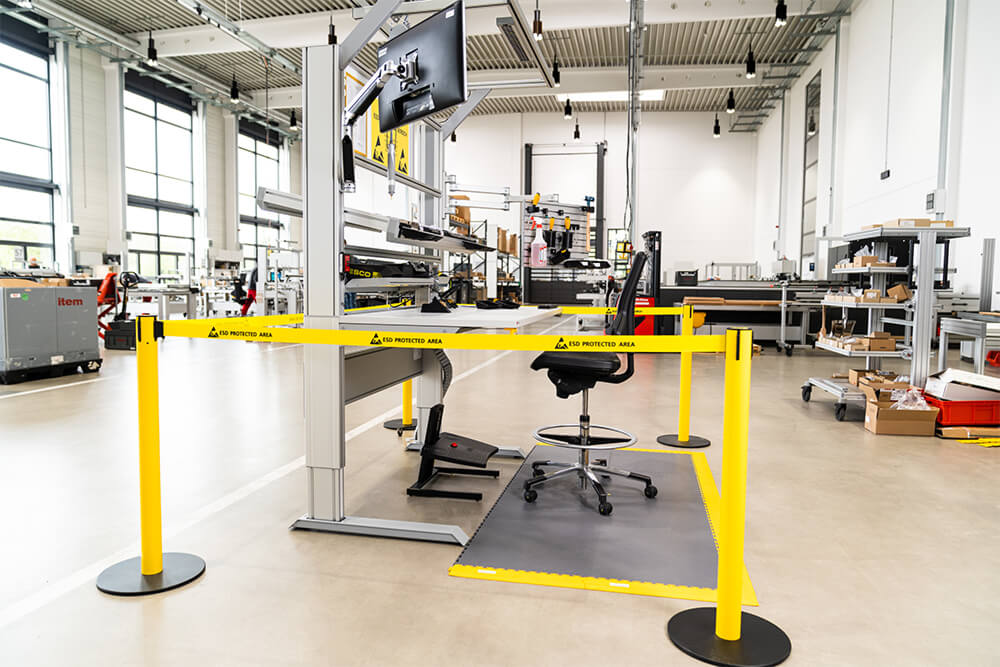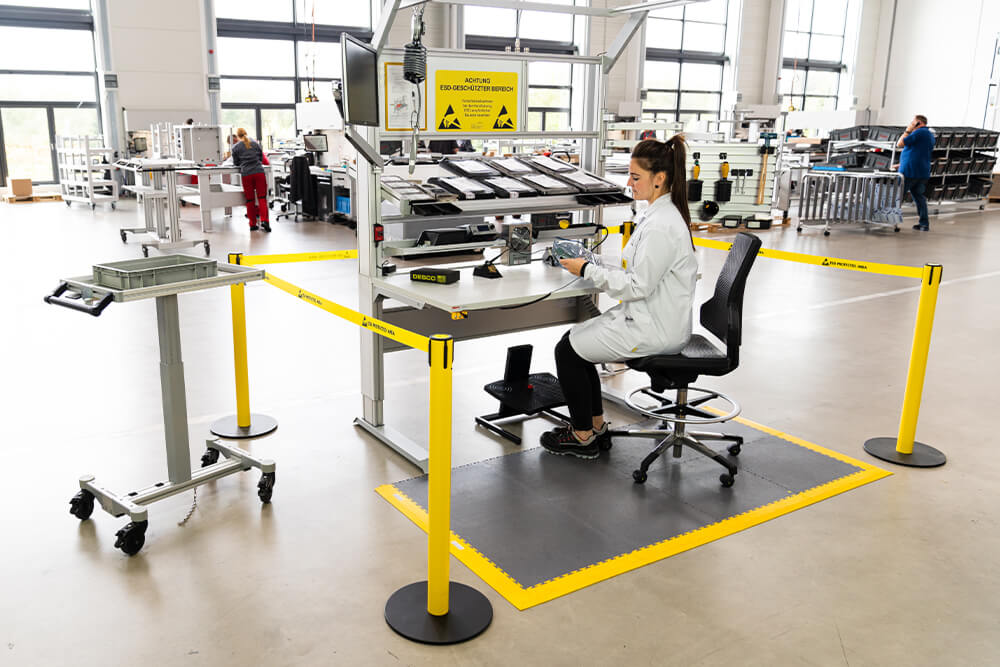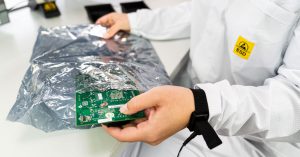ESD is an abbreviation you often come across in industrial environments. These three letters stand for electrostatic discharge.
In our everyday lives, we’ve almost certainly all experienced what ESD feels like – when touching a metal door handle or shaking hands, for instance. You then quite literally get a shock! Let’s start with a definition of ESD. An electrostatic discharge of this kind is the result of the uncontrolled equalisation of electrical charges between two objects charged with different voltages. The threshold for human perception of this discharge is around 3500 volts. Whereas a voltage of this magnitude is unpleasant but not dangerous for humans, it’s a different story for ESD-sensitive (ESDS = electrostatic discharge sensitive) components. Even a discharge of 5 volts is sufficient to cause a defect, and such damage often only comes to light at a later stage. This can lead, for example, to official complaints being received. Companies that produce or process components of this kind should therefore pay a great deal of attention to ESD and appropriate ESD safety measures, including both a comprehensive safety concept and the use of ESD-safe components.

Guide: The 10 golden rules of ESD safety
Specialist expertise in all aspects relating to effective protection against ESD at the workstation, presented in a compact format that includes a practical checklist for continuously enhancing ESD safety in your company.
Get the white paper now
How exactly does ESD (electrostatic discharge) occur?
It’s very common for electrostatic charges to build up when two materials with different electrostatic potentials rub against each other or are pulled apart. However, this can also happen simply when they come into contact with each other. This is also referred to as a triboelectric effect, which takes its name from the triboelectric series (see below). This series indicates the strength and polarity of a material’s charge. In other words, it is immediately apparent which materials have a tendency to give up electrons and become positively charged. When an electrostatic charge builds up, materials at the positive end of the triboelectric series thus transfer electrons to materials at the negative end. The exact opposite occurs at the negative end of the series.
Even when people are just walking normally, they often build up an electrostatic charge. Their footwear rubs on the ground, especially given that the soles are separated from the ground with every single step.
Lots of these “positive” materials are used in industrial production. Ensuring appropriate protection when manufacturing and handling ESD-sensitive components is therefore an absolute priority. In this connection, it’s important to bear in mind that a charge can also be transferred via material in the direct vicinity that is already charged. Even when people are just walking normally, they often build up an electrostatic charge. Their footwear rubs on the ground, especially given that the soles are separated from the ground with every single step. These triboelectric processes generate a voltage that passes into our bodies via our clothing and is stored in various places, including our skin and hair. Things we are wearing that act as insulators, such as synthetic rubber and plastic soles, further increase this effect. Consequently, normal work shoes don’t offer adequate ESD protection.

Significance and consequences of ESD damage for companies
ESD damage to electronic components typically occurs either on contact between people and electronics (e.g. via hand and tool) or when touching charged components. Virtually every type of electronic system with integrated circuits is affected by the risk of ESD. Such systems contain a combination of multiple electronic semiconductor elements – such as transistors, diodes and other active and passive parts – that are joined together. Due to the microscopically small circuit paths and structures of electronic components, even the relatively low voltages resulting from ESD have devastating consequences. The associated potential equalisation is similar to a tiny lightning strike. Another factor to consider is that the growing miniaturisation of electronic components means circuits are becoming less resilient. As a result, ESD safety will become even more important in the future.
Example of the consequences of undetected ESD damage
Because ESD is “invisible”, ESD damage often only comes to light at a very late stage. The example described below is a realistic scenario. Friction between the floor and the soles of an employee walking through a workshop has built up an electrostatic body charge of around 1500 volts. As soon as the employee touches an electronic component during the packaging process, this results in an uncontrolled discharge into the electronic system and damages one of the microscopically small circuit paths in a chip. As the discharge voltage was below 3500 volts, however, it goes totally unnoticed, but 50 volts is already sufficient to cause some damage. Since the circuit path was only slightly damaged, it remains intact for a certain period. Consequently, this defect isn’t detected during the quality control process either. Following delivery to the customer, everything also works perfectly to start with.
It’s particularly important not to underestimate the loss of image and trust associated with ESD damage.
Over time, the current pulses during normal operation steadily worsen the ESD damage. The circuit path is ultimately damaged to such an extent that it causes a short-circuit. The key problem is the long delay in the damage manifesting itself. A failure occurs at a highly critical point in the production process. With damage of this kind, it normally takes around eight hours to identify and replace the defective part. Under its warranty, the manufacturer is required to replace the component and therefore incurs additional costs. That’s not the only consequence of ESD damage, though. The customer’s trust in the company has also taken a big hit. Consequently, this customer may look for an alternative manufacturer. It’s particularly important not to underestimate the loss of image and trust associated with ESD damage.

Online training – ESD safety in theory and practice
Find out even more about how to specifically prevent uncontrolled electrostatic discharges – all you need to access our two interactive online training modules is a free item user account.
Spotlight on the electrostatic protected area (EPA)
This raises the question of how ESD damage and its consequences can be prevented. A comprehensive ESD safety concept is called for, including the designation of a central ESD coordinator, appropriate staff training and regular testing of the ESD safety function. Our free white paper “The 10 golden rules of ESD safety” tells you everything you need to know about what an ESD safety concept should cover. In this post, we focus on the electrostatic protected area (EPA), as it clearly illustrates the basic principles of ESD safety. Electronic components must always be handled and assembled in an area of this kind, where all materials used need to be electrostatically dissipative and earthed to the same potential. This means electrostatic charges and differences in potential can be specifically prevented. Basically speaking, EPAs can be anything from a single workstation or a defined space to an entire building.
Whereas access to a UPA is unrestricted, only trained staff and appropriately briefed visitors with the necessary protective equipment can enter an EPA.
The highly practical free Work Bench Configurator from item makes it easy to define a particular ESD-safe work bench’s EPA, which is then visualised. The online tool expressly indicates when non-ESD-safe components are positioned in this area. The opposite of an EPA also has its own term and abbreviation. It is known as an unprotected area (UPA). Whereas access to this unprotected area is unrestricted, only trained staff and appropriately briefed visitors with the necessary protective equipment can enter an EPA. Only trained members of staff are permitted to handle ESD-sensitive components. Within the EPA, special packaging rules apply to ESD-sensitive components. If materials in which electrostatic charges can build up need to be used inside the EPA due to process-related considerations, their electrostatic field must not exceed 100 V/cm. Otherwise, the field strength must be reduced by initiating additional measures such as ionisation or increasing the humidity.

Floors and work shoes to protect against uncontrolled electrostatic discharges
ESD flooring is an essential part of any EPA. A conductive earth connection is established to make sure electrostatic charges are safely dissipated. DIN EN 61340-5-1 ff. stipulates that a permanently installed floor must consist of several layers, with multiple copper strips ensuring discharge to the earth. Companies can choose between permanently installed and temporary ESD flooring. Both options have their advantages and disadvantages. A permanent floor lasts a long time, its properties remain unchanged and, in some cases, it has an extremely high load-bearing capacity, but it is comparatively expensive. Temporary floor coverings are more affordable and enable changes to be made quickly in areas that have already been set up. They have a low load-bearing capacity, though, especially given that they only have a limited service life. The choice therefore depends entirely on the specific situation.
Normal shoes, including work shoes, often act as insulators. By contrast, wearing conductive footwear or earthing shoe straps establishes a conductive connection between your body and the ESD flooring.
Given that it is highly relevant for ESD safety, ESD flooring must always be kept in perfect condition. It’s important to note that wax-based floor care and cleaning products are unsuitable. Work shoes with ESD protection are also vitally important. After all, if there is no electrical contact between a person and conductive, earthed ESD flooring, the intended effect will not be achieved. Normal shoes, including work shoes, often act as insulators. By contrast, wearing conductive, ESD-safe footwear or earthing shoe straps establishes a conductive connection between your body and the ESD flooring. This safely dissipates electrostatic charges that build up while you are walking. The conductive electrical connection of staff via their work shoes should be checked on a daily basis. Personnel grounding testers (PGTs) are used for this purpose.
Special products for use in the EPA
It goes without saying that what applies in general to the EPA is compulsory for the work benches located in this area. As far as possible, materials in which electrostatic charges can build up must not be used in the handling area. If phones or IT terminals are essential, maintaining safety distances from the handling area is absolutely vital. Generally speaking, the entire work area should be earthed and electrostatically dissipative. That applies in particular to:
- Work benches
- Chairs
- Under-bench drawer units
- Drawers
- Racks
- Transport trolleys
ESD work benches from item, for instance, are equipped with a volume-conductive table top. In an ESD table top, volume conductivity is achieved using chipboard that incorporates graphite power. The table top’s coating layer also has full volume conductivity thanks to its carbon-based particles. ESD table mats, too, are suitable for handling operations in small areas. In addition, an ESD wristband for personnel grounding should be worn when working at an ESD workbench. All components – from the table top to accessories – are earthed via the table frame.
Tools such as screwdrivers, soldering irons and measuring devices come into direct contact with ESD-sensitive components.
Parts containers, storage boxes, covers and tools must also be made of electrostatically dissipative material. Tools such as screwdrivers, soldering irons and measuring devices come into direct contact with ESD-sensitive components. If these are electrostatically dissipative, any charge that builds up can dissipate in a controlled manner. Incidentally, just like normal work shoes, office chairs represent a significant risk factor from an ESD safety perspective. As a result of the large number of materials used to make these chairs, they are often not electrostatically dissipative. DIN EN 61340-5-1:2009; Part 5-1 (Supplement 1) therefore stipulates that only electrostatically safe seating (chairs) can be used when working in an EPA.
ESD-safe transport and material supply trolleys
With friction and movement wherever you look, protecting electronic components during transport and storage is particularly important. ESD safety can be ensured by using special protective packaging, suitable containers and, above all, electrostatically dissipative transport and material supply trolleys. Profiles and fastening technology from item are generally ideal for electrostatically dissipative designs, as they are made of aluminium. What’s more, numerous components that have been developed specifically to guard against uncontrolled electrostatic discharges are available. Accessories such as ESD drag chains and antistatic castors provide transport trolleys with additional protection. As a basic principle, ESD-safe work benches and factory equipment from item are subjected to a control measurement prior to delivery to assess their ability to dissipate electrostatic charges.

Key abbreviations relating to ESD safety at a glance
ESD | Electrostatic discharge
ESDS | Electrostatic discharge sensitive
EPA | Electrostatic protected area
UPA | Unprotected area
Free knowledge archive relating to ESD safety measures
Posts about assembly work bench design have formed an integral part of the item blog since its early days. You will find an overview of all these posts in the comprehensive blog category “Assembly work bench systems”. This also covers a number of other ESD-related topics, including the EPA function in the Work Bench Configurator. In addition, you can download a total of four free documents in PDF format on a dedicated page:
- ESD safety – the basics in layman’s terms
- ESD work bench – reliable, simple and fast to plan
- ESD safety measures for industry
- ESD – Visible protection from invisible dangers
- Identifying ESD damage using an electron microscope
- Configure ESD benches online with exceptional ease
- Four PDFs in the ESD media centre relating to the 10 golden rules of ESD safety, the basics of ESD safety, setting up an electrostatic protected area and how an ESD safety concept works in practice
Would you like to keep up-to-date with developments relating to ergonomics and preventing ESD? Then we have something that’s right up your street! Simply subscribe to the item blog by completing the box at the top right.





